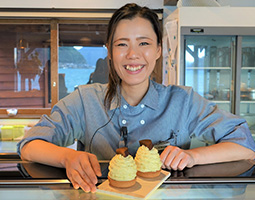Home > Highlighting JAPAN > Highlighting Japan February 2018 > Revitalizing the Regions
Highlighting JAPAN


The Lure of a Kyoto Fishing Village
A small fishing village facing population decline is enjoying a revival, drawing on its unique scenery as a tourism resource and uniting its residents in the process.
In the north of the Tango Peninsula, Kyoto Prefecture, lies a fishing village called Ine blessed with an attractive harbor facing the Sea of Japan. Ine is famous for its funaya (boathouse) scenery, which blends into the natural surroundings.
The first floor of a funaya is used as a boat garage and work space, and the second floor as a living area. A narrow path runs behind the funaya on the mountain side separating the funaya from the property’s main building. Residents living here come and go between the funaya and the main buildings.
There are currently about 230 funaya forming an unbroken line along the bay, some of which date back to the Edo period (1603–1867). Owing to this unique historical scenery, Ine is the first fishing village to have been selected as one of Japan’s Important Preservation Districts for Groups of Traditional Buildings. As such, any house repairs require municipal permission and adherence to strict regulations concerning the use of Japanese roof tiles and lumber. Ine also restricts shops from putting up signboards as a way for the town to jointly preserve the funaya scenery that blends so well with nature.
Although sporting beautiful scenery, the population of Ine Town, presently around 2,000, has been declining. Wanting to slow the population decline, since taking office twelve years ago Mayor Hideki Yoshimoto has worked to communicate Ine’s appeal to the world and draw tourists to the town. Yoshimoto explains, “There is a limit to industries like fishing and farming that require workers and depend heavily on weather conditions. What this town needed to survive was not simply harvesting, but a change in awareness among residents to think about market needs and marketing. I wanted to activate the town’s tourism industry as an initiator for that.”
In order to increase the settled population, people outside needed to find out about Ine, and Yoshimoto thought the key was tourism.
Yoshimoto began working on branding the town for tourism centering on the funaya. He communicated the appeal of Ine’s beautiful scenery by having the town join The Most Beautiful Villages in Japan and The Most Beautiful Bays in the World. Moreover, he recruited people from outside the area to communicate online about local products and the funaya lifestyle from a new perspective.
Yuuri Ohkubo, originally from Kyushu, moved to Ine in August 2016, and is in charge of publicity at the town hall. She says, “I moved here after seeing a newspaper article recruiting for the Local Vitalization Cooperator in Ine [overseen by the Ministry of Internal Affairs and Communications]. There’s neither a convenience store nor supermarket here, but I don’t feel it’s particularly inconvenient thanks to Internet services and the support of other residents. More people are moving here, and we have lively socials for new residents who come from all over the place, such as the Kanto region and Taiwan, so I always feel connected to other people.”
The town hall works to provide livelihood support to new residents while endeavoring to bring in more new residents and tourists from abroad in the future. The town’s Tourism Association has staff that speak English, Chinese (Taiwanese Hokkien, Cantonese) and Spanish.
The town’s steady efforts and the rise of SNS in recent years has resulted in an increase in tourists to Ine from within Japan and abroad, with the number of foreign tourists doubling annually for the past three years, led by visitors from Taiwan and Hong Kong. It is not what the townspeople had expected, but turning the small boats in the bay into sea taxis on the suggestion of an overseas student became an instant hit among tourists. The increase in tourism has naturally awoken a spirit of hospitality among the townspeople, prompting residents to suggest walking tours around the town that introduce the lifestyles and history of Ine.
Ine plans to renovate vacant funaya into accommodation for rent by the spring of 2019. Building on this opportunity, the refurbishment of funaya for hospitality purposes is increasing, creating spaces where tourists can experience Ine’s sea up close.
Shiho Nagahama is the shop manager of Ine Café, which is run by Sabai, the designated manager of Funaya Biyori, a tourism and exchange facility in Ine. She says, “I came back here after ten years away and was astonished by how the town’s tourism had developed. I make use of my experience as a pastry chef in Osaka and bake cakes here at the town’s only café, providing a space where tourists can enjoy the scenery while having a tea break.”
Ine has turned its natural appearance as a fishing village into a tourism resource, and its beautiful scenery interweaving traditional funaya buildings with the bay is now visible to the world. Driving this transformation was a leader’s passion, the suggestion of an overseas student, and the ideas of new residents of Ine. Welcoming new people has drawn out Ine’s appeal to the fullest, and the people of this town on a small bay now gaze out to the wide sea full of hope for the future.
© 2009 Cabinet Office, Government of Japan









